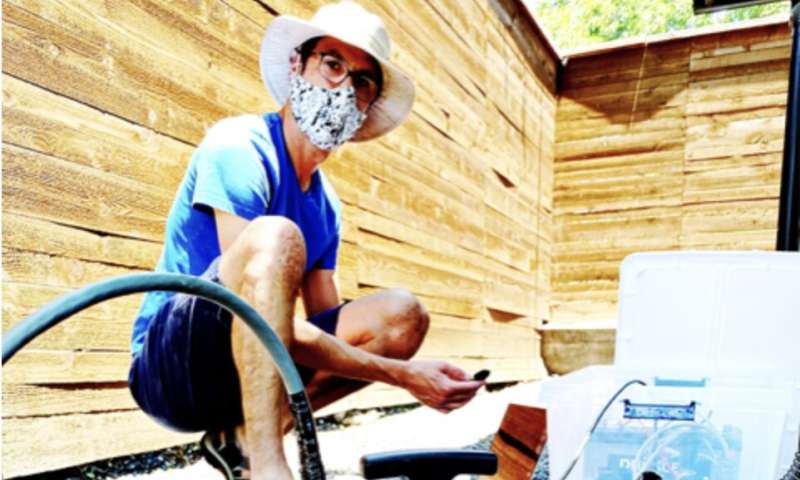Massive Hunga volcano eruption sets new standard for crowdsourcing scientific observation of seismic events

The massive Jan. 15 eruption of the undersea Hunga Tonga-Hunga Ha'apai volcano in the South Pacific Ocean was a once-in-a-century event that allowed an international group of 76 scientists using multiple forms of technology to crowdsource their data in ways never before possible.
SMU geophysicist Stephen Arrowsmith, one of the co-authors of the eruption analysis published in Science, says this was the first time that infrasound waves from a single event were measured globally by multiple stations. Infrasound is generally too low for humans to hear, but can be measured with equipment that mimics the way a human eardrum captures sound.
"What's cool about this is all the different ways that you could measure this event with seismic sensors, acoustic sensors in the atmosphere, acoustic sensors in the oceans, and satellite measurements," Arrowsmith said. "It's really a multi-phenomenological study."
The Hunga eruption on Jan. 15, 2022 was the largest in a series that began Dec. 19, 2021, producing audible sound as far away as Alaska. It was comparable in size to the historic 1883 Krakatau eruption that destroyed more than 70 percent of the Indonesian island and archipelago of the same name. Measuring a similarly powerful eruption using new technology has given scientists the ability to learn from Hunga what they could only speculate about Krakatoa.
"People heard Krakatoa," Arrowsmith said. "But the only way people actually measured Krakatoa was with weather instruments—barometers—which measure the very low frequency changes in the atmosphere. They didn't have satellites, and they didn't have seismometers around the world. They didn't have infrasound sensors that were in the atmosphere, or acoustic sensors within the ocean. So, this is actually the first time that an event like this has been recorded in this way."
Infrasound is used to measure both natural and man-made phenomena, with volcanoes, meteors and explosions such as bomb blasts registering at the loudest end of the spectrum. Earthquakes generate infrasound as well as seismic waves. Scientists also point to a biological role for infrasound, as some animals—such as elephants—seem particularly attuned to low-frequency sounds. For example, Arrowsmith said, there were reports in that elephants in Sumatra moved inland to safety after a 2004 earthquake in the Indian Ocean, but before a deadly tsunami rolled over the Indonesian island.
The expertise of SMU's Huffington Department of Earth Sciences in infrasound stems from its longstanding role using seismic and acoustic data to help ensure that the world's nations comply with nuclear testing agreements as spelled out in the Comprehensive Nuclear Test Ban Treaty. SMU geoscientists also played a leading role in determining that disposal wells used to inject wastewater from oil and gas operations were responsible for a spate of small earthquakes that began rattling North Texas in 2008.
A total of 53 infrasound monitors stationed globally recorded data from the Hunga eruption, including SMU's long-running infrasound sensors located in South Korea, West Texas, and on the roof of Moody Coliseum on the SMU campus.
Arrowsmith and the other two members of the SMU team, staff scientist Junghyun Park and postdoctoral researcher Gil Averbuch, pooled their data with that of the other researchers collaborating on the study, which was led by volcanologist Robin S. Matoza at U.C. Santa Barbara. Matoza used "Slack" collaboration software to organize and collect data from the extremely large group of participating scientists.
Because infrasound travels so slowly, the SMU team learned of the volcanic eruption several hours before it began registering on their equipment. "We thought, 'This is going to be an amazing event.' And then when we looked at the data and—sure enough—we had these beautiful signals," Arrowsmith said.
The equipment that measures infrasound in the air is very small—not much bigger than a triple-thick hockey puck. Most infrasound sensors measure the motion of a thin metal diaphragm that vibrates with the sound waves. Because wind can mask sound waves, infrasound sensors typically collect pressure over an area.
"One of the most exciting things about this event is that we don't understand how infrasound was detected everywhere on Earth," Arrowsmith said, "because normally infrasound is very sensitive to the direction of the wind. So normally we hear infrasound in the direction the wind is blowing, and we don't hear it where it's not. But this event was heard everywhere. So the infrasound was traveling slightly differently from what we're used to."
Technology made it possible for the extraordinarily large group of scientists to collect their data and share their findings quickly—a powerful lesson in the value of big data in the geosciences, Arrowsmith said.
"I recently published a paper in Reviews of Geophysics called Big Data Seismology that talks about some of the exciting opportunities in seismology with the Big Data Revolution," Arrowsmith said. Written with SMU co-author Beatrice Magnani and four others, the paper spells out three drivers of the revolution—advances in data, algorithms and computing that are applicable to all aspects of seismology.
"The discipline of seismology is based on observations of ground motion that are inherently undersampled in space and time," the paper notes. "Our basic understanding of earthquake processes and our ability to resolve 4D Earth structure are fundamentally limited by data volume. Today, Big Data Seismology is an emergent revolution involving the use of large, data-dense inquiries that is providing new opportunities to make fundamental advances in these areas."
About SMU
SMU is the nationally ranked global research university in the dynamic city of Dallas. SMU's alumni, faculty and over 12,000 students in eight degree-granting schools demonstrate an entrepreneurial spirit as they lead change in their professions, communities and the world.
More information:
Robin S. Matoza et al, Atmospheric waves and global seismoacoustic observations of the January 2022 Hunga eruption, Tonga, Science (2022). DOI: 10.1126/science.abo7063
Provided by Southern Methodist University